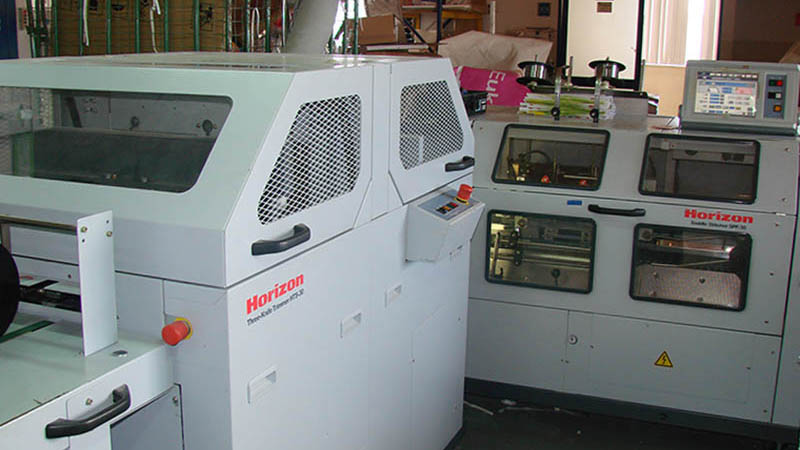
Two automatic collating machines
Finishing includes several disciplines that are applied to many different kinds of works. The diversity is such that it's better to just stay at the main cases.
The guillotine
The first operation, before printing, is to cut the papers or cardboards to the correct size for every different printer, to get them to work at the maximum efficiency level – and that means mostly to work with paper near their maximum dimensions. If the page to print is much smaller than the printer's maximum paper, normally the page is repeated to achieve the same number of copies with less prints.
Once printed, the work must return to the guillotine one ore more times, either to divide the printing sheets before collating, either to be trimmed in the end.
The books
Thinking about collating and binding, the first idea is books. It would not be economical nor practical to print every page in a book one by one, and so they are grouped in printing sheets, usually close to the maximum dimensions of the printer or the available paper.
Those printing sheets must be collated, folded, cut, stacked in a sequence of automatic operations by a big specialized machine, resulting in the book body with all the pages in the correct sequence. There is another machine that puts the cover, sets hot glue or stitches in the spine and trims the book. Christmas cards with unusual folds and trims, packages and other pieces of more original conception often oblige the finishing department to do it by hand or use their equipment more creatively.
Magazines and mailings
Magazines, brochures and catalogs are not very different from books and they go through the same operations. Instead of spine stitching, used only in books, magazines can be spine glued or stapled. In this case, the stapling is also done by the collating machine.
Publications must often be mailed. Then we can envelope or pack them in plastic skin. Addresses may have been included in the printing, or we can add sticker address labels or cover sheets, printed by us from a client address database. If the client desires, we can post the mailing ourselves.
Forms
Carbonless form books or sets, once offset or digitally printed and numbered, are collated and bound in the same machines we use for the books. Other normal operations in finishing are the perforated lines (used in invoices with detachable sheets), hole punching, stapling, eyelet placement (for clothes labels) and ring or spiral binding. All those operations require their own machines, but more than that, experienced staff.
Packaging
This is the last operation entrusted to the finishing department: to pack the printed works, label and send them, in orders going from a small set of personal cards to hundreds of volumes in pallets weighing in total several tons.